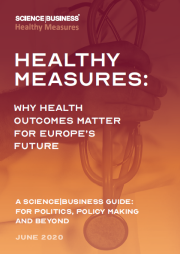The pandemic has hugely amplified the importance of measuring health outcomes – both in Europe and beyond. Which steps can health leaders take to embed this in the heart of post-COVID systems and policies? A new Science|Business guide explores the options.
Get your free copy

COVID-19 has shattered many conventions about how healthcare should be designed and delivered in Europe. Beyond the sheer numbers of fatalities, millions of existing patients – whether those in palliative or social care, or those suffering from cancer and other chronic diseases – have lost access to treatment while resources have been moved to cope with the pandemic. Europe’s commitment to universal health coverage has come up short in the most testing circumstances.
Nonetheless, Europe’s citizens are eager for a new vision of a stable, healthy future beyond COVID-19. If silver linings are to be found around the pandemic, one is surely the unique window of opportunity for health leaders to “build back better”, to rethink the balance and structure of today’s models, and to make our next generation of health systems truly fit for purpose.
At the heart of this process is the issue of how to measure and determine the outcomes generated by the investments Europe makes in its healthcare. With an extended downturn looming, the pressure on health leaders to meet citizens’ demands and needs, with potentially fewer resources, will only grow. Which only increases the relevance and appeal of the blindingly simple idea behind measuring health outcomes: whatever works, do more of it. If a certain system of management, type of medicine or style of doctoring cures more people than another, repeat and scale those approaches. Focus on the outcomes. Collect the data. Analyse it. And then act on it.
In this guide, we set out a range of considerations for politicians, policy makers, administrators and regulators who believe that outcomes need to be part of any serious discussion about future health policy and programmes. From championing cross-border health data initiatives and integrating real world evidence into disease management programmes, to linking outcomes with payment schemes and investing in digital skills and infrastructures, it offers a roadmap for change, and some practical signs on how to reach the desired destination.
TABLE OF CONTENTS
FOREWORD
By Xavier Prats Monné, Chief Advisor to the Board, EIT Health; Special Advisor, Teach for All; and former Director-General for Health and Food Safety, European Commission
EXECUTIVE SUMMARY
SECTION I: THE JOURNEY TO DATE
- Healthy Measures: A rationale
- Outcome differentials across borders
- Outcome differentials within borders
- The problem of unmet needs
- The economic case for change
- From cost to value: A critical shift
- Measuring outcomes: A systems perspective
- Measuring outcomes: Data standards
- Measuring outcomes: An organisational perspective
- Measuring outcomes: A clinical perspective
SECTION II: THE JOURNEY AHEAD
- The road to recovery
- Europe’s new health agenda
- Connecting the policy dots
- Towards an economy of wellbeing
- The economics of wellbeing
- Stand and deliver: Leaders needed
- Recommendations: Data
- Recommendations: People
- Recommendations: Incentives
- Recommendations: Advocacy
- Conclusions
ABOUT HEALTHY MEASURES

 A unique international forum for public research organisations and companies to connect their external engagement with strategic interests around their R&D system.
A unique international forum for public research organisations and companies to connect their external engagement with strategic interests around their R&D system.